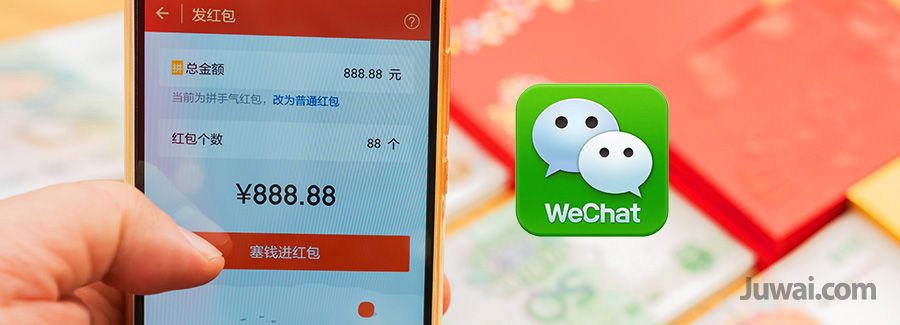You've successfully copied this link.
How digital sales surged online this Chinese New Year 2017

760,000 – that’s how many digital hongbao that were sent per second at the stroke of Chinese New Year.1
Giving hongbao (红包) – red envelopes or red packets with cash as a monetary gift – is a Chinese tradition during Chinese New Year believed to symbolise good luck and ward off evil spirits.
As more and more Chinese take their festive celebrations online, this explosion of online cash gifting on Chinese New Year Eve delivered a 43% y-o-y increase that saw a whopping 46 billion digital hongbao exchanged on Tencent's WeChat2 in just six days during the Chinese New Year Golden Week holidays.
This perfectly demonstrates how Chinese consumers have taken to digitally-enhanced products and services3 like ducks to water, and emphasises how online is the way to go in China.
China’s online audience: 5x the size of Russia
China’s colossal online market lies at the base of what amounts to a highly lucrative phenomenon.
China is now home to 731 million internet users – five times the size of Russia’s whole population4 – and 695 million smartphone users by the end of 2016.5
This huge user base fuelled red-hot demand for data during Chinese New Year, pushing data usage during the holiday period up to a whopping 259 million gigabytes6 – double the total consumed in 2016 – as Chinese increasingly chose to spend their Chinese New Year time online.
Even the usual generation gap caused by technology may soon not pose too big of a hindrance here in China – a recent survey revealed that 95.2% of Chinese respondents plan teach their parents to be more tech-savvy by showing them how to send a digital hongbao on smartphones.7
More importantly, aside from hongbao cash packets, rocketing online usage during Chinese New Year drove a business bonanza for online-focused companies as well, such as China UnionPay, the biggest payment processing company in China.
China UnionPay reported ¥462 billion in total online payments for 343 million transactions during the 2017 Chinese New Year holiday, a y-o-y growth of 48.1% and 11.7%, respectively, compared to the same period in 2016.8
- Fresh produce: Rather than elbowing their way through crowds in local markets, Chinese consumers have increasingly turned to online vendors to buy their fresh produce for holiday cooking. Total online sales of fresh goods saw a massive 400% increase, with imported goods seeing a 13-fold increase compared to Chinese New Year 2016.9
- Goods delivery: According to China’s Ministry for Postal Services, the tide of online orders saw China Post delivering 13.75 million deliveries between 20 January and 2 February 2017 alone.10
- Online cinema tickets: A record-breaking ¥3.38 billion cinema tickets were sold during the Chinese New Year holiday, up 3% y-o-y.11 While this was a boon for cinemas, it also generated ¥190 million in booking fees for online ticket vendors, such as Maoyan, WePiao, and Nuomi.12
The huge growth figures seen during the recent Chinese New Year prove, once again, that online channels are the most effective way of targeting Chinese consumers
4 examples of excellence
If those Chinese New Year numbers still aren’t enough to convince you, these four brands expanding online in China are prime examples showing online expansion as the way forward to target Chinese buyers.
 #1 Burberry
#1 Burberry
As one of the leading foreign high-end retailers in the China market, the global fashion house built its online presence on Alibaba’s Tmall portal13, and beefed up its presence on WeChat14 in time for Chinese New Year with themed promotions. Even amid a challenging environment for high-end retailers in China, Burberry has carved out a niche in the market, which now accounts for a quarter of its global sales15, with sales recently increasing around 2% y-o-y.16
 #2 Four Seasons
#2 Four Seasons
The luxury hotel chain has built and active presence on Weibo and WeChat. During the recent Chinese New Year holiday, Four Seasons reached out to Chinese travellers with its own hongbao activity17, where users shake their phones to grab a hongbao, which would then offer them the chance to win a two-night stay at a Four Seasons hotel. It’s activities like this, and their prioritisation of online channels in China, that have garnered the Four Seasons hotel chain an award for best social media marketing channel.18
 #3 BMW
#3 BMW
BMW has built a position in the top three automakers in China19, which is already the world’s largest car market. How did they achieve this? An active online strategy that includes a company website offering the opportunity to tailor make your car order20, TMall sales platforms for auto parts and extras21, plus a WeChat featuring event and new model information, plus the opportunity to sign up for a test drive22 – that’s how.
 #4 Starbucks
#4 Starbucks
Starbucks has flourished in China, and is aiming to double its location to 5,000 stores in the coming five years. Having locked onto the fact that Chinese mobile payment has now become a necessary way of life in China, Starbucks quickly adapted and started accepting WeChat pay in December 2016. Most recently, Starbucks partnered with WeChat to announce a social gifting promotion as part of their Valentine’s Day campaign, and it appears that they are the first retail brand to leverage WeChat’s social gifting feature and create an online-to-offline social gifting platform in China.23, 24
The promotional campaign, called ‘Say it with Starbucks’ (用星说) – a wordplay on the Chinese phrase ‘Say it with Your Heart’ (用心说) – not only allows Chinese consumers to seamlessly send coffees or gift certificates to friends or loved ones via WeChat, but also enables Starbucks to tap into hundreds of millions WeChat’s users.23, 24
3 ways to work online into your China plan
With these cases in mind, it’s time to get serious about targeting the Chinese market, especially with the prospect of increasing demand from Chinese buyers for overseas property as China’s middle-class grows, overseas visa rules relax, and airlines add more flights between China and the rest of the world.
Here are three quick tips to set your China strategy plan into motion:
#1 Get online and social
Publishing your listings online will put you in front of China’s 731 million internet users, many of whom are growing increasingly interested in overseas property. What’s most essential, though, is ensuring that your listings are visible to those 731 million Chinese netizens behind China’s Great Firewall, such as on Juwai.com, which is hosted on both sides of the Great Firewall, and receives 2 million unique visitors per month. Leveraging China's social media is crucial as well, such as WeChat. In fact, 35% of all time spent on mobile in China is actually used on WeChat, while 55% of all time on mobile is spent within Tencent products.25
#2 Prioritise presentation and user experience
Competition for the highly lucrative Chinese market is ratcheting up, so it’s imperative that everything about your offering, including pictures, information, and descriptions, is as detailed and polished as possible. Chinese are used to browsing online for domestic properties – where competition for buyers’ attention is already fierce – so they will be expecting high standards and convenient access, such as QR Codes and mobile access.
#3 Integrate your online presence with data monitoring
Knowing that Chinese are keen on overseas property is one thing, but knowing what makes them tick is another. Beyond just having an online presence, having access to the right data will show you what kind of Chinese are searching to property hunt, which type of properties they prefer, and where they are looking to buy, thus helping you to target your sales accordingly.
As Chinese buyers continue to shift their spending online, China’s online expansion is set to grow from ¥5.16 trillion ($752 billion) in 201626 to ¥7.5 trillion by 2018.27
With prospects like these, and with surging Chinese interest in overseas property, now is the time to ratchet up your online presence to catch a share of one of the biggest business opportunities of the next five years.


